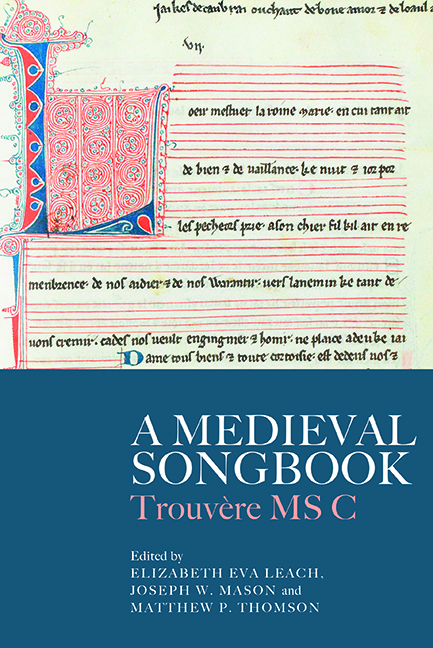Book contents
- Frontmatter
- Contents
- List of Illustrations
- List of Music Examples
- List of Tables
- List of Contributors
- Acknowledgements
- Abbreviations
- Editorial Practices
- Introduction
- Chapter 1 The Trouvère Manuscripts of the Burgerbibliothek Bern
- Chapter 2 The Lorraine Repertoire of C
- Chapter 3 Chansonnier C: Contents, Stemmatic Position, Particularities
- Chapter 4 A Note on the Decoration of C and its Artistic Context
- Chapter 5 Author Ascriptions and Genre Labels in C
- Chapter 6 Common Exemplars of U and C
- Chapter 7 Shared Small Sources for Two Early Fourteenth-Century Metz Chansonniers?
- Chapter 8 The Legacy of Thibaut de Champagne in C
- Chapter 9 Strategies of Appropriation in Jacques de Cambrai's Devotional Contrafacts
- Chapter 10 Jeux-Partis and their Contrafacts in C
- Chapter 11 C and Polyphonic Motets: Exemplars, Adaptations, and Scribal Priorities
- Appendix: List of Songs in C
- Bibliography
- Index of Sources
- Index of Songs
- General Index
- Studies in Medieval and Renaissance Music
Chapter 7 - Shared Small Sources for Two Early Fourteenth-Century Metz Chansonniers?
Published online by Cambridge University Press: 26 May 2022
- Frontmatter
- Contents
- List of Illustrations
- List of Music Examples
- List of Tables
- List of Contributors
- Acknowledgements
- Abbreviations
- Editorial Practices
- Introduction
- Chapter 1 The Trouvère Manuscripts of the Burgerbibliothek Bern
- Chapter 2 The Lorraine Repertoire of C
- Chapter 3 Chansonnier C: Contents, Stemmatic Position, Particularities
- Chapter 4 A Note on the Decoration of C and its Artistic Context
- Chapter 5 Author Ascriptions and Genre Labels in C
- Chapter 6 Common Exemplars of U and C
- Chapter 7 Shared Small Sources for Two Early Fourteenth-Century Metz Chansonniers?
- Chapter 8 The Legacy of Thibaut de Champagne in C
- Chapter 9 Strategies of Appropriation in Jacques de Cambrai's Devotional Contrafacts
- Chapter 10 Jeux-Partis and their Contrafacts in C
- Chapter 11 C and Polyphonic Motets: Exemplars, Adaptations, and Scribal Priorities
- Appendix: List of Songs in C
- Bibliography
- Index of Sources
- Index of Songs
- General Index
- Studies in Medieval and Renaissance Music
Summary
Among the dozens of surviving manuscripts that collect the repertoires of thirteenth- century French song are three that can be associated with the city of Metz. Situated in a linguistic and political border zone, Metz was an important regional centre of medieval book production and had a flourishing cultural life. One of these three songbooks, U, represents the earliest large-scale collection of notated trouvère songs, as well as containing one of the few significant collections of notated troubadour songs. Unsurprisingly, this manuscript has already had considerable attention from literary scholars and musicologists. Although far from entirely neglected, somewhat less work has been lavished on the other two Messine sources that are addressed here, C, the Bern chansonnier, the focus of the present volume, and the trouvère chansonnier I, now bound as part of Oxford, Bodleian Library, MS Douce 308. For text scholars, this neglect may reflect the supposed geographical peripherality of these sources; for musicologists, it is probably because neither of these sources has musical notation: C planned for it but now displays empty staves, while I copied its songs verbally as prose, in a layout never designed to accommodate musical notation.
Despite their differences, C and I were copied in the same city at roughly the same time (with C preceding I by a likely maximum of two decades), and together represent the ‘terminus ad quem of trouvère tradition and chansonnier compilation’. Paola Moreno adheres to Eduard Schwan's nineteenth-century diagnosis of the date of the source, noting that C was copied ‘between the end of the thirteenth and start of the fourteenth centuries’. The collection in I contains a song which references a person by a title that means that the collection was copied after 1309, although probably not too long after that time. Now that both manuscripts exist in high-quality digital photographs available online, they can be compared visually side-by-side. To my eye, the shapes of the alternating red and blue capitals and the decoration of initial letters have some similarities, although they are not completely the same, making it possible that they emanated from the same milieu, even if not from the pen of the same individual.
- Type
- Chapter
- Information
- A Medieval SongbookTrouvère MS C, pp. 121 - 145Publisher: Boydell & BrewerPrint publication year: 2022

